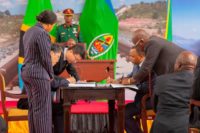Indonesia sprung a surprise on Thursday, suspending a $5.5-billion high-speed-rail project that is being implemented by a Chinese company and financed by the China Development Bank.
The decision came soon after Indonesian President Joko Widodo attended a groundbreaking ceremony organized by the contractor, PT Kereta Cepat Indonesia China (KCIC), which is a joint venture comprising four state-owned Indonesian companies and China Railway International Co. Ltd.
The high-speed-rail plan is meant to connect two major cities, Jakarta and Bandhung, across a distance of 142 kilometers. This segment is part of a larger, 750-km-long project that would traverse four provinces and end in Surabaya, the country’s second-biggest city.
The transport ministry, which blocked the project, blamed the company for failure to come up with development design, technical illustrations, field data and other specifications. In addition, there are some unresolved issues that need to be sorted out before issuing the concession agreement, the ministry said.
“We are very strict [on this] because this is the first time we’ve conducted this kind of project, and we are not done with the evaluation,” Transportation Minister Ignasius Jonan said.
There are signs of serious differences between the company and Indonesia’s transportation ministry on several issues, including sharing the risks of default and conducting essential studies, such as a hydrological survey.
Besides, the company has issued some of the documents in Chinese, which officials in Jakarta find difficult to understand.
“We still haven’t received the required documents. There are even a lot of documents in Chinese. How can we even evaluate them?” the ministry’s director general of railways, Hermanto Dwiatmoko, said earlier.
Renegotiations Ahead?
Indonesian sources said the transport ministry may not be satisfied until the railway builders provide the documents they had not furnished earlier. It may demand a renegotiation on several issues, such as risk factors, before completing the concession agreement.
The unissued concession agreement is meant to cover issues such as risk of default and the duration of the concession. In fact, the ministry has not even issued the building permit for the first 5 km of the railway.
There also are differences concerning a business plan and a bank guarantee of 5% of total investments. Further, the project has not yet acquired the 600-plus hectares of land it needs.
One of the ministry’s requirements is that, in case construction does not proceed for any reason, the company restore the project site to its original condition.
“We want to ensure that if the project’s development fails in the middle of construction, the government will not be burdened by it,” the minister said.
He referred to a 2004 dispute between the government and a construction company after a monorail project in Jakarta had been held up, adding that he did not want a repeat of that situation.
Under the original plan, work on the Jakarta-Bandung project was set to begin this year and be completed by 2019. The track is designed to ensure a speed of 350 km per hour for passenger trains.
So far, KCIC, the builder, has received some of the necessary licenses—including track-route permits, a railway transportation-firm permit, an environmental impact analysis (Amdal) and a toll-road land-use permit—from different ministries, including the Public Housing and Public Works Ministry.
Painful Decision
For the Chinese company, the transport ministry’s decision is painful because it managed to muscle out Japan’s Kawasaki Heavy Industries by arranging soft loans from the China Development Bank, which has agreed to come up with 75% of the cost.
The Japanese government reacted sharply when, in October of last year, Jakarta awarded the project to the Chinese-led consortium.
“I’m confident Japan put forward the best and most practical plan,” its chief cabinet secretary, Yoshihide Suga, said. “The policy suddenly changed. It’s hard to understand how the Chinese plan was adopted, and I can only describe it as extremely regrettable.”
This is the second major Chinese-backed high-speed-rail project to be canceled. Mexico pulled out of a $3.7-billion project in 2014. Long months of bitter negotiations over compensation were finally settled in May 2015, when Mexico agreed to pay China Railway Construction Corp. $1.31 million.
Longest Span Bridge
It is not all gloom and doom these days for Chinese railway executives. The government of Vietnam has just announced it will carry out a feasibility study for a major railway project, which will be constructed by Chinese companies.
After months of reluctance, Laos has offered the Chinese funding worth $500 million for a railway project, which will be built by Chinese companies. A local minister said that, after accepting his government’s request for low rates, China has agreed to extend the loan for less than 3%.
Along Nu River in China’s Yunnan province on Jan. 24, work began on what is expected to become the world’s longest span bridge, according to the Chinese ministry of railways.
The steel-truss railroad bridge is part of the China-Myanmar Railway project, Yan Shuxin, a director from China Railway 18 Bureau Group, said. The project is being built to connect China's Kunming and Myanmar's Yangon over a length of 1,920 km, including a 690-km-long section in China.
Yan said it would require rare precision to manufacture 46,000 tons of steel trusses. Assembly at high altitude poses some major risks, he added.
The Nu River bridge is to have a total length of 1,024 meters. The height of the bridge above the river will be 211 m. The bridge mainly will use steel-truss arch beams with a span of 490 m.
The railway station will be built on a deck, due to the special topography of the Nu River and Gaoligong mountains. The width of the deck will reach 24.9 m, which will make it the widest railway bridge of its kind in China, Yan said.



Post a comment to this article
Report Abusive Comment